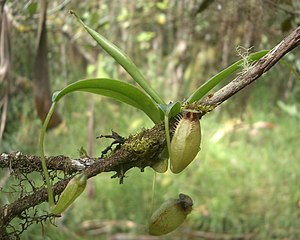Nepenthes aristolochioides
| Nepenthes aristolochioides | ||||||||||||
|---|---|---|---|---|---|---|---|---|---|---|---|---|

Nepenthes aristolochioides |
||||||||||||
| Systematics | ||||||||||||
|
||||||||||||
| Scientific name | ||||||||||||
| Nepenthes aristolochioides | ||||||||||||
| Jebb & Cheek |
Nepenthes aristolochioides is a carnivorous plant from the genus of pitcher plants ( Nepenthes ). It wasfirst describedin 1997 by botanists Mathew Jebb and Martin Cheek . Their species name is an allusion to the genus of the pipe winds ( Aristolochia ), whose flowers show a striking resemblance to the pitchers of N. aristolochioides .
description
Vegetative characteristics
Nepenthes aristolochioides is a climbing subshrub whose shoots can reach between 5 and 8 meters in length. The stem axis is three to five centimeters thick and cylindrical, the internodes 7 to 10 centimeters long.
The sessile, leathery, light green leaves are formed from an 8 to 14 centimeter long and three centimeter wide, lanceolate-spatulate leaf blade which, in the strict sense, is just a transformed leaf base . This is divided by a strong central rib, six to ten side ribs run from its base from the central rib, from these in turn the leaf nerve is irregularly reticulated. At the edges it is covered with white hair.
The tendril that grows out at the tip of the leaf base is around twice as long as the leaf base, does not form a loop and at its end merges into the base of the pot.
Like many pitcher plant species, Nepenthes aristolochioides also has a so-called “pot dimorphism”, so the pitchers close to the ground differ from the air pitchers.
The ivory-colored to pale red and numerous red-spotted, bubble-shaped, leathery ground jugs are thick-walled, 5 to 7 centimeters high and 2.5 to 3 centimeters wide, their inside is completely glandular. They have two fringed wings that run from the base of the can to the peristome (the edge of the can opening) and are up to 1 millimeter wide. The fringes are 0.5 to 2 millimeters apart and 3 to 5 millimeters long. The pitcher opening is circular to ovoid and up to 1.5 centimeters wide.
Unlike other species of the genus, it does not point upwards, but is offset to the side and sits at an incline, vertically pointing outwards at the top of the jug. The red to dark red peristome is flattened, 7 to 20 millimeters wide, the ribs are 0.3 to 0.5 millimeters apart, the teeth on the inner edge are two to three times as long as they are wide. The lid, which points diagonally downwards over the opening, is circular to ovoid with a diameter of 1 to 1.5 centimeters, with large glands on the entire surface (especially near the midrib), there are no outgrowths on the underside. From its middle rib three clearly protruding side ribs go off on each side. On the underside, the lid is continuously red, on the top it is yellowish with small red spots.
The air cans are slender, trumpet-shaped, 7 to 10 centimeters high and 2.5 to 4 centimeters wide. The pitcher opening points almost vertically outwards, the peristome is 4 to 6 millimeters wide. The lid is egg-shaped and traversed by three to four side ribs extending from the central rib. In all other respects they are the same as the floor jugs.
Inflorescences, flowers, fruits and seeds
Like all pitcher plants, Nepenthes aristolochioides is dioeciously separate sexes ( dioecious ), that is, a plant is either female or male, but never hermaphroditic. The female racemose inflorescences are 14 to 15 inches long. The inflorescence stalk is 4 to 5 inches long and 2 to 4 millimeters thick. The pedicels of the lower flowers are 12 millimeters long, those of the upper 6 millimeters.
The capsule fruits are 15 to 20 millimeters long. The seeds are thread-like.
distribution
Nepenthes aristolochioides is only known from Tujuh Mountain in Central Sumatra at altitudes between 2000 and 2200 m. It is believed, however, that there are also deposits on the neighboring Kerinchi , the highest mountain in Sumatra.
Endangerment status
Although the deposits are located in the Kerinchi-Seblat National Park and are therefore protected, Nepenthes aristolochioides is severely threatened by illegal collections by "plant lovers". The IUCN therefore lists the species as "critically endangered".
Botanical history
Nepenthes aristolochioides was first collected in 1956 by Willem Meijer , who gave his copy to the then Rijksherbarium of the University of Leiden . This copy (which was in poor condition) was first viewed by Joachim Nerz in 1988 . After consultation with Willem Meijer and the view of photographic evidence, it became clear that it was a species not previously described. In the summer of 1996, Mink went to Sumatra to find the species again and was successful. In the following year the species was first described by Matthew Jebb and Martin Cheek .
literature
- Joachim Nerz : Rediscovery of an outstanding Nepenthes: N. aristolochioides (Nepenthaceae). In: Carnivorous Plant Newsletter. Vol. 27, No. 3, 1998, ISSN 0190-9215 , pp. 101-114, ( online ).
Individual evidence
- ↑ Nepenthes aristolochioides in the endangered Red List species the IUCN 2006 Posted by: Clarke, CM, R. Cantley, J. Mink, H. & A. Generic Wistuba, 2000. Retrieved on 11 August, 2007.

